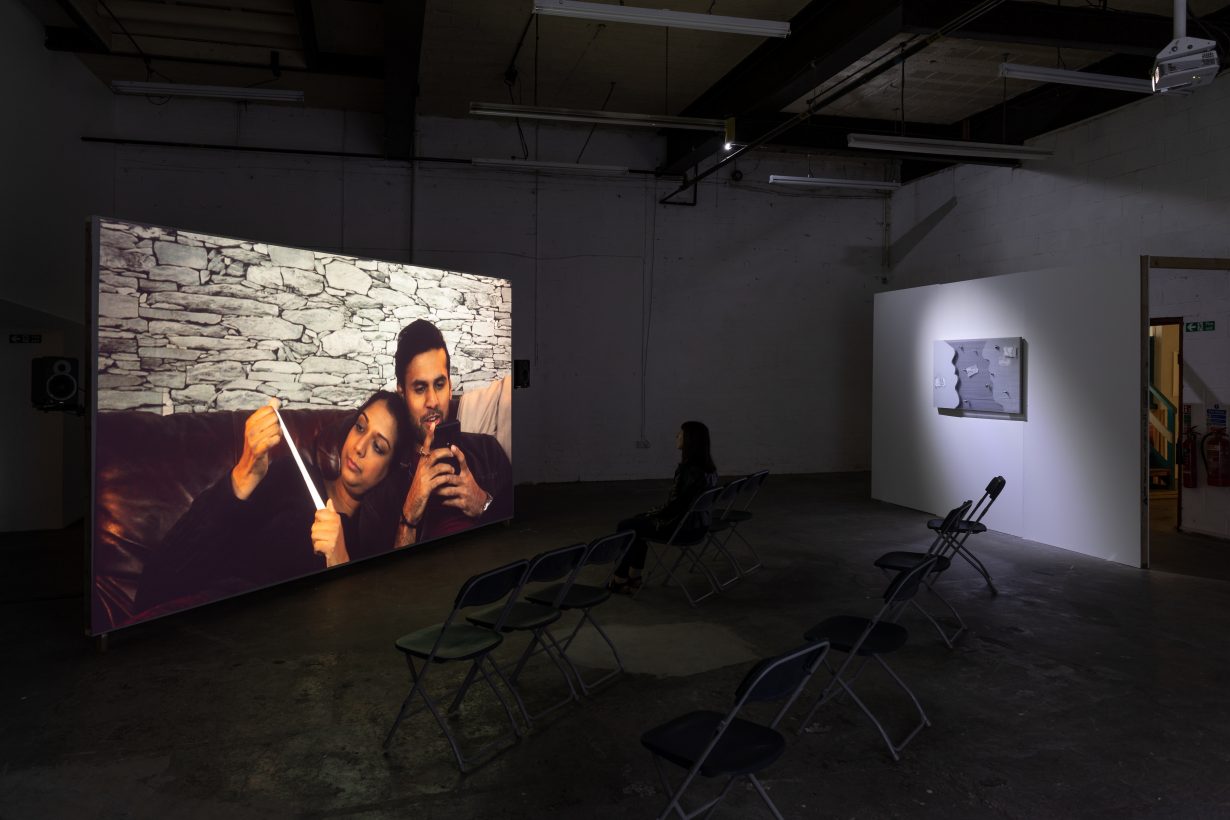How do fictional characters cope when their sense of reality starts to collapse?
Two Queens, Leicester
Karanjit Panesar’s film Actor, Container (2021) might begin with a conversation between its two protagonists, a man and a woman, in a car driving around the daytime streets of Leicester. Or perhaps it begins with a man chopping an onion in a kitchen while describing a book whose characters successively vanish whenever their stories are read, only to be replaced by the characters of those who read them. Perhaps it ends with a low-key bhangra-style dance routine in a deserted bar, or with a woman watching herself (or maybe her own doppelganger) presenting an online TV show on her mobile phone, while it clearly, albeit impossibly, takes place live.

These multiple possibilities are the result of a film played on a continuous loop. Our sense of its beginning and end is determined by the arbitrary points at which any particular viewer enters or leaves the gallery space. The film itself, shot in a quasi-documentary style, draws together a scripted, but intricately tangled, series of obliquely philosophical conversations, banal or inexplicable incidents, marking shifts between the different layers of a seemingly unstable reality. Loosely based on Douglas Hoftstadter’s notion of the ‘strange loop’ in art, music and mathematics, the film as a whole functions like one of MC Escher’s impossible staircases, where every ascent the eye traces within the image is returned to its starting point on the bottom step.

Panesar links his current interest in the ‘strange loop’ form with previous explorations of agency and authenticity under capitalism. Panesar’s exhibition at London’s Arebyte gallery in 2018, The Way Things Are, explored the pervasiveness of neoliberal ideas and the apparent refusal to acknowledge coherent alternatives, in an installation of film, sculpture and ceramics where lines between digital and physical media were deliberately blurred. In Actor, Container, the digital film is similarly displayed alongside wall-mounted objects: cut-out fragments of stylised faces in profile framing rough, storyboard-style sketches alluding to, or perhaps anticipating, scenes and conversations from the film itself.

‘I have been thinking a lot about what authentic experience means after cinema, and about the difference between characters and people’, Panesar explains in response to an email question about his use of the strange loop as a narrative form. ‘There is a feedback loop that exists when people imitate characters they relate to, when those characters are engineered to be relatable. Perhaps this is a cynical view, but we do live in an attention economy where meme-able characters fare better than those with depth. Perhaps the interest in ‘strange loops’ is due to the fact that these structures also express something widely experienced in the ‘post-truth’ age, which is the fundamental uncertainty of things, a feeling that any given reality is up for grabs.’
The ‘strange loop’ might also represent a closed system, a feeling of entrapment inside a hall of mirrors where every journey, however meandering or determined to break the cycle ends up precisely back where it began. If the protagonists of Actor, Container are trying to make sense of a world where cause and effect seem to have broken down, and all sense of identity is dissolved in a kind of dream logic, then their philosophical discussions, oblique parables and everyday exchanges about petrol stations can only ever lead them further from certainty before they begin again.
Karanjit Panesar: Actor, Container is at Two Queens, Leicester, 18 May – 24 July
This article is part of Remark, a new platform for art writing in the East Midlands by ArtReview in collaboration with BACKLIT. Read more here and sign up for the Remark newsletter here
